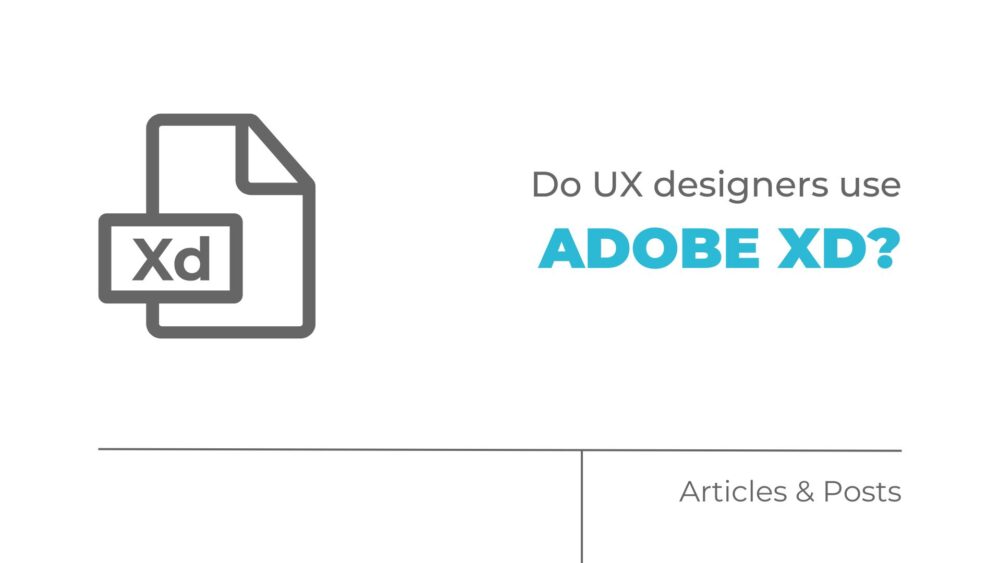Whether you’re a head of design or a UX designer, having the right tools is essential to streamline their workflow and bring their design ideas to life.
Wondering, “Do UX designers use Adobe XD?”
Yes, UX designers often use Adobe XD as a key part of their toolkit.
It’s a popular choice due to its comprehensive design, prototyping, and collaboration features, making it an ideal tool for creating user-friendly designs.
Let’s learn a little more about what other programs UX designers use on a regular basis.
What Adobe programs do UX designers use?
Adobe offers a range of software programs that are widely used by UX designers to create and prototype designs.
Here are some of the key Adobe programs commonly used in UX design:
1. Adobe XD
Adobe XD is specifically designed for UX/UI designers.
It allows designers to create interactive prototypes, collaborate with stakeholders, and test their designs for user feedback.
With its powerful features like artboards, responsive resizing, and component states, Adobe XD provides a comprehensive solution for UX designers to create seamless user experiences.
2. Adobe Photoshop
Photoshop is a versatile program that is extensively used by designers, including UX designers.
While primarily known as an image editing tool, Photoshop also offers valuable features for creating and editing visual elements in UX design.
Designers can use it to refine graphics, create custom icons, and optimize images for web and mobile platforms.
3. Adobe Illustrator
Illustrator is another popular Adobe program utilized by UX designers.
It is primarily known as a vector graphics editor, making it ideal for creating scalable and high-quality visual assets.
UX designers often rely on Illustrator to design icons, illustrations, and other graphical elements that enhance the overall user experience.
4. Adobe After Effects
Though not as commonly used as the previous programs, Adobe After Effects can be a valuable addition to a UX designer’s toolkit.
It allows designers to create motion graphics and animations that bring interfaces to life.
By adding subtle animations and transitions, UX designers can enhance the usability and engagement of their designs.
Other user experience design essentials
In addition to Adobe programs, there are several other essential tools and resources that UX designers often rely on:
1. Sketch
Sketch is a popular design tool among UX/UI designers, especially those working on macOS.
It offers an intuitive interface and robust features for designing interfaces and creating interactive prototypes.
Sketch also has a vibrant community and an extensive library of plugins that extend its capabilities.
2. InVision
InVision is a prototyping and collaboration tool widely used in the UX design industry.
It allows designers to create interactive prototypes, gather feedback, and collaborate with stakeholders.
InVision integrates seamlessly with other design tools and offers cloud storage for design files, making it a valuable asset for UX designers.
3. Wireframing tools
Wireframing is an essential step in UX design, and there are several dedicated tools available for creating wireframes.
Tools like Balsamiq, Axure RP, and Figma provide designers with a range of features to quickly sketch out ideas, define information architecture, and create low-fidelity prototypes.
If you are wanting to add any of these programs to your toolbox, we suggest talking with your creative director or head of design.
At the End of the Day
Adobe XD is indeed a popular choice among UX designers.
Its intuitive interface, robust features, and seamless integration with other Adobe programs make it a valuable tool for creating exceptional user experiences.
However, UX designers often utilize a combination of Adobe programs and other essential tools like Sketch, InVision, and wireframing tools to enhance their workflow and bring their design concepts to life.
Remember, choosing the right tools ultimately depends on the individual designer’s preference, project requirements, and collaboration needs.
By staying up-to-date with the latest tools and continuously refining their skillset, UX designers can deliver outstanding user experiences that delight users and drive business success.


Comments are closed.